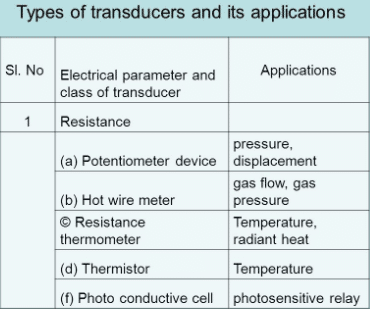Different Types of Transducers and Their Applications


“A transducer is an electronic device that converts energy from one form to another.”Common types of transducers include microphones, loudspeakers, thermometers, position and pressure sensors and antenna. Although not generally thought of as transducers, photocells, LEDs, and even common light bulbs are transducers.
Efficiency of transducer
Efficiency is an important consideration in any transducer. Transducer efficiency is defined as: “The ratio of the power output in the desired form to the total power input. Mathematically, if P represents the total power input and Q represents the power output in the desired form, then the efficiency E, as a ratio between 0 and 1, is given by:
E = Q/P
If E% represents the efficiency as a percentage, then:
E% = 100 Q/P
No transducer is 100% efficient; some power is always lost in the conversion process. Usually, this loss is manifested in the form of heat. Some antennas approach 100% efficiency. A well-designed antenna supplied with 100 watts of radio frequency (RF) power radiates 80 or 90 watts in the form of an electromagnetic field. A few watts are dissipated as heat in the antenna conductors, the feed line conductors, dielectric, and in objects near the antenna. Among the worst transducers, in terms of efficiency, are incandescent lamps. A 100-watt bulb radiates only a few watts in the form of visible light. Most of the power is dissipated as heat; a small amount is radiated in the UV (ultraviolet) spectrum.
Transducers may be categorized by application: sensor, actuator, or combination.
See also: Types of thermometers
Sensor
A sensor is used to detect a parameter in one form and report it in another form of energy (usually an electrical and/or digital signal). For example, a pressure sensor might detect pressure (a mechanical form of energy) and convert it to electricity for display at a remote gauge.
Read Also: Sensor Vs Transducer
An Actuator
An actuator accepts energy and produces movement (action). The energy supplied to an actuator might be electrical or mechanical (pneumatic, hydraulic, etc). An electric motor and a loudspeaker are both transducers, converting electrical energy into motion for different purposes.
Combination transducers have both functions, they both detect and create action. For example, a typical ultrasonic transducer switches back and forth many times a second between acting as an actuator to produce ultrasonic waves and acting as a sensor to detect ultrasonic waves.
Applications of transducers
Electromagnetic:
- Antenna: Converts electromagnetic waves into electric current and vice versa.
- Cathode ray tube: It converts electrical signals into visual form.
- A fluorescent lamp, light bulb: It converts electrical power into visible light.
- Tape head: It converts changing magnetic fields into electrical form.
- Hall effect sensor: It converts a magnetic field level into electrical form only.
Electrochemical
- pH probes
- Hydrogen sensor
Electromechanical:
Electromechanical output devices are generally called actuators. Examples are:
- Galvanometer
- Rotary motor, linear motor
- Vibration power generator
- Potentiometer when used for measuring the position
- The load cell converts force to mV/V electrical signals using a strain gauge.
- Accelerometer
- Strain gauge
Electroacoustic:
- Loudspeaker, earphone: It converts electrical signals into sound.
- Microphone: It converts sound into an electrical signal.
- Piezoelectric crystal: It converts solid-state electric modulations into an electrical signal.
- Hydrophone: It converts changes in water pressure into an electrical form.
Photoelectric:
- A laser diode, the light-emitting diode: They convert electrical power into forms of light.
- Photodiode, photoresistor, phototransistor, photomultiplier tube: They convert changing light levels into electrical form.
Thermoelectric:
- RTD resistance temperature detector
- Thermocouple
- Thermistor
Radioacoustic:
- Geiger Muller tube used for measuring radioactivity.
Types of transducers
-
Temperature transducer:
Temperature can be measured in different ways. Two methods of sensing are very important.
- Mechanical methods
- Electrical methods
Electrical methods:
- They are generally based upon the principle of thermal expansion materials.
- Different materials have different temperature coefficients.
- Mechanical temperature sensors generally convert temperature into motion or position.
To see related topics visit our page: Electricity and magnetism
Recent Posts
Is energy quantized in classical physics?
No, according to classical wave theory the emission of electromagnetic radiations from the surface is…
Types of laser
Basically, there are four types of laser which includes: Gas Lasers Solid State lasers Liquid…
Ultrasound frequency range
What is ultrasonics? The study and application of mechanical vibrations with frequencies beyond the limits…
Electromagnetic Energy: What are some examples of it?
Electromagnetic energy definition Electromagnetic energy is the amount of energy stored in a region of…
Fundamental units and Derived Units with Examples
The Main Difference between fundamental Units and Base units is that Units that Express base…
Newton’s First law of Motion Examples in Our Daily Life
Newton's first law of motion states that " A body continues its state of rest…
View Comments